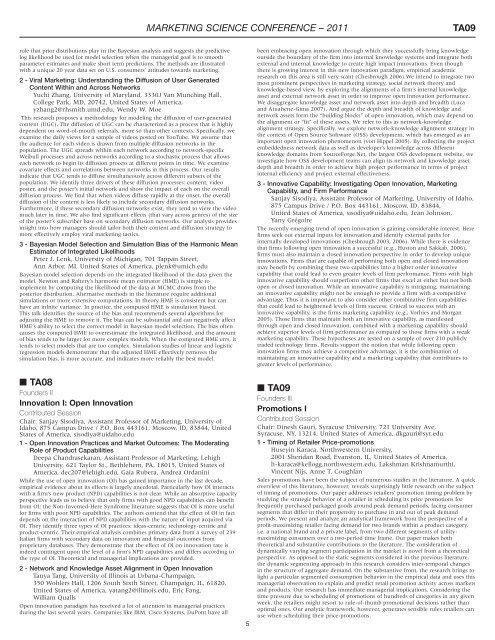2012 INFORMS Marketing Science Conference June 7
2012 INFORMS Marketing Science Conference June 7
2012 INFORMS Marketing Science Conference June 7
You also want an ePaper? Increase the reach of your titles
YUMPU automatically turns print PDFs into web optimized ePapers that Google loves.
ole that prior distributions play in the Bayesian analysis and suggests the predictive<br />
log likelihood be used for model selection when the managerial goal is to smooth<br />
parameter estimates and make short term predictions. The methods are illustrated<br />
with a unique 20 year data set on U.S. consumers’ attitudes towards marketing.<br />
2 - Viral <strong>Marketing</strong>: Understanding the Diffusion of User Generated<br />
Content Within and Across Networks<br />
Yuchi Zhang, University of Maryland, 3330J Van Munching Hall,<br />
College Park, MD, 20742, United States of America,<br />
yzhang2@rhsmith.umd.edu, Wendy W. Moe<br />
This research proposes a methodology for modeling the diffusion of user-generated<br />
content (UGC). The diffusion of UGC can be characterized as a process that is highly<br />
dependent on word-of-mouth referrals, more so than other contexts. Specifically, we<br />
examine the daily views for a sample of videos posted on YouTube. We assume that<br />
the audience for each video is drawn from multiple diffusion networks in the<br />
population. The UGC spreads within each network according to network-specific<br />
Weibull processes and across networks according to a stochastic process that allows<br />
each network to begin its diffusion process at different points in time. We examine<br />
covariate effects and correlations between networks in this process. Our results<br />
indicate that UGC tends to diffuse simultaneously across different subsets of the<br />
population. We identify three drivers of these diffusion processes: content, video<br />
poster, and the poster’s initial network and show the impact of each on the overall<br />
diffusion process. We find that when videos diffuse rapidly at the onset, the overall<br />
diffusion of the content is less likely to include secondary diffusion networks.<br />
Furthermore, if these secondary diffusion networks exist, they tend to view the video<br />
much later in time. We also find significant effects (that vary across genres) of the size<br />
of the poster’s subscriber base on secondary diffusion networks. Our analysis provides<br />
insight into how managers should tailor both their content and diffusion strategy to<br />
more effectively employ viral marketing tactics.<br />
3 - Bayesian Model Selection and Simulation Bias of the Harmonic Mean<br />
Estimator of Integrated Likelihoods<br />
Peter J. Lenk, University of Michigan, 701 Tappan Street,<br />
Ann Arbor, MI, United States of America, plenk@umich.edu<br />
Bayesian model selection depends on the integrated likelihood of the data given the<br />
model. Newton and Raftery’s harmonic mean estimator (HME) is simple to<br />
implement by computing the likelihood of the data at MCMC draws from the<br />
posterior distribution. Alternative methods in the literature require additional<br />
simulations or more extensive computations. In theory HME is consistent but can<br />
have an infnite variance. In practice, the computed HME is simulation biased.<br />
This talk identifies the source of the bias and recommends several algorithms for<br />
adjusting the HME to remove it. The bias can be substantial and can negatively affect<br />
HME’s ability to select the correct model in Bayesian model selection. The bias often<br />
causes the computed HME to overestimate the integrated likelihood, and the amount<br />
of bias tends to be larger for more complex models. When the computed HME errs, it<br />
tends to select models that are too complex. Simulation studies of linear and logistic<br />
regression models demonstrate that the adjusted HME effectively removes the<br />
simulation bias, is more accurate, and indicates more reliably the best model.<br />
■ TA08<br />
Founders II<br />
Innovation I: Open Innovation<br />
Contributed Session<br />
Chair: Sanjay Sisodiya, Assistant Professor of <strong>Marketing</strong>, University of<br />
Idaho, 875 Campus Drive / P.O. Box 443161, Moscow, ID, 83844, United<br />
States of America, sisodiya@uidaho.edu<br />
1 - Open Innovation Practices and Market Outcomes: The Moderating<br />
Role of Product Capabilities<br />
Deepa Chandrasekaran, Assistant Professor of <strong>Marketing</strong>, Lehigh<br />
University, 621 Taylor St., Bethlehem, PA, 18015, United States of<br />
America, dec207@lehigh.edu, Gaia Rubera, Andrea Ordanini<br />
While the use of open innovation (OI) has gained importance in the last decade,<br />
empirical evidence about its effects is largely anecdotal. Particularly how OI interacts<br />
with a firm’s new product (NPD) capabilities is not clear. While an absorptive capacity<br />
perspective leads us to believe that only firms with good NPD capabilities can benefit<br />
from OI; the Non-Invented-Here Syndrome literature suggests that OI is more useful<br />
for firms with poor NPD capabilities. The authors contend that the effect of OI in fact<br />
depends on the interaction of NPD capabilities with the nature of input acquired via<br />
OI. They identify three types of OI practices: ideas-centric; technology-centric and<br />
product-centric. Their empirical analysis combines primary data from a survey of 239<br />
Italian firms with secondary data on innovation and financial outcomes from<br />
proprietary databases. They demonstrate that the effect of OI on innovation rate is<br />
indeed contingent upon the level of a firm’s NPD capabilities and differs according to<br />
the type of OI. Theoretical and managerial implications are provided.<br />
2 - Network and Knowledge Asset Alignment in Open Innovation<br />
Tanya Tang, University of Illinois at Urbana-Champaign,<br />
350 Wohlers Hall, 1206 South Sixth Street, Champaign, IL, 61820,<br />
United States of America, yatang2@illinois.edu, Eric Fang,<br />
William Qualls<br />
Open innovation paradigm has received a lot of attention in managerial practices<br />
during the last several years. Companies like IBM, Cisco Systems, DuPont have all<br />
MARKETING SCIENCE CONFERENCE – 2011 TA09<br />
5<br />
been embracing open innovation through which they successfully bring knowledge<br />
outside the boundary of the firm into internal knowledge systems and integrate both<br />
external and internal knowledge to create high impact innovations. Even though<br />
there is growing interest in this new innovation paradigm, empirical academic<br />
research on this area is still very scant (Chesbrough 2006).We intend to integrate two<br />
most prominent perspectives in marketing strategy, social network theory and<br />
knowledge-based view, by exploring the alignments of a firm’s internal knowledge<br />
asset and external network asset in order to improve open innovation performance.<br />
We disaggregate knowledge asset and network asset into depth and breadth (Luca<br />
and Atuahene-Gima 2007). And argue the depth and breadth of knowledge and<br />
network assets form the “building blocks” of open innovation, which may depend on<br />
the alignment or “fit” of these assets. We refer to this as network-knowledge<br />
alignment strategy. Specifically, we explore network-knowledge alignment strategy in<br />
the context of Open Source Software (OSS) development, which has emerged as an<br />
important open innovation phenomenon (von Hippel 2005). By collecting the project<br />
embeddedness network data as well as developer’s knowledge across different<br />
knowledge domains from SourceForge.Net, the largest OSS development website, we<br />
investigate how OSS development teams can align its network and knowledge asset<br />
depth and breadth in order to achieve high project performance in terms of project<br />
internal efficiency and project external effectiveness.<br />
3 - Innovative Capability: Investigating Open Innovation, <strong>Marketing</strong><br />
Capability, and Firm Performance<br />
Sanjay Sisodiya, Assistant Professor of <strong>Marketing</strong>, University of Idaho,<br />
875 Campus Drive / P.O. Box 443161, Moscow, ID, 83844,<br />
United States of America, sisodiya@uidaho.edu, Jean Johnson,<br />
Yany Grégoire<br />
The recently emerging trend of open innovation is gaining considerable interest. Here<br />
firms seek out external inputs for innovation and identify external paths for<br />
internally developed innovations (Chesbrough 2003, 2006). While there is evidence<br />
that firms following open innovation a successful (e.g., Huston and Sakkab, 2006),<br />
firms must also maintain a closed innovation perspective in order to develop unique<br />
innovations. Firms that are capable of performing both open and closed innovation<br />
may benefit by combining these two capabilities into a higher order innovative<br />
capability that could lead to even greater levels of firm performance. Firms with high<br />
innovative capability should outperform other firms that excel at either but not both<br />
open or closed innovation. While an innovative capability is intriguing, maintaining<br />
an innovative capability might not be enough to provide a firm with a competitive<br />
advantage. Thus it is important to also consider other combinative firm capabilities<br />
that could lead to heightened levels of firm success. Critical to success with an<br />
innovative capability, is the firms marketing capability (e.g., Vorhies and Morgan<br />
2005). Those firms that maintain both an innovative capability, as manifested<br />
through open and closed innovation, combined with a marketing capability should<br />
achieve superior levels of firm performance as compared to those firms with a weak<br />
marketing capability. These hypotheses are tested on a sample of over 210 publicly<br />
traded technology firms. Results support the notion that while following open<br />
innovation firms may achieve a competitive advantage, it is the combination of<br />
maintaining an innovative capability and a marketing capability that contributes to<br />
greater levels of performance.<br />
■ TA09<br />
Founders III<br />
Promotions I<br />
Contributed Session<br />
Chair: Dinesh Gauri, Syracuse University, 721 University Ave,<br />
Syracuse, NY, 13214, United States of America, dkgauri@syr.edu<br />
1 - Timing of Retailer Price-promotions<br />
Huseyin Karaca, Northwestern University,<br />
2001 Sheridan Road, Evanston, IL, United States of America,<br />
h-karaca@kellogg.northwestern.edu, Lakshman Krishnamurthi,<br />
Vincent Nijs, Anne T. Coughlan<br />
Sales promotions have been the subject of numerous studies in the literature. A quick<br />
overview of this literature, however, reveals surprisingly little research on the subject<br />
of timing of promotions. Our paper addresses retailers’ promotion timing problem by<br />
studying the strategic behavior of a retailer in scheduling its price promotions for<br />
frequently purchased packaged goods around peak demand periods, facing consumer<br />
segments that differ in their propensity to purchase in and out of peak demand<br />
periods. We present and analyze an analytical framework from the perspective of a<br />
profit-maximizing retailer facing demand for two brands within a product category,<br />
i.e. a national brand and a private label, from two different segments of utilitymaximizing<br />
consumers over a two-period time frame. Our paper makes both<br />
theoretical and substantive contributions to the literature. The consideration of<br />
dynamically varying segment participation in the market is novel from a theoretical<br />
perspective. As opposed to the static segments considered in the previous literature,<br />
the dynamic segmenting approach in this research considers inter-temporal changes<br />
in the structure of aggregate demand. On the substantive front, the research brings to<br />
light a particular segmented consumption behavior in the empirical data and uses this<br />
managerial observation to explain and predict retail promotion activity across markets<br />
and products. Our research has immediate managerial implications. Considering the<br />
time pressure due to scheduling of promotions of hundreds of categories in any given<br />
week, the retailers might resort to rule-of-thumb promotional decisions rather than<br />
optimal ones. Our analytic framework, however, generates sensible rules retailers can<br />
use when scheduling their price-promotions.

















